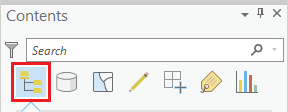Prior to beginning this tutorial, you will need to have either completed the Introduction to GIS Data Management tutorial, or you will
This course will teach you how to download, evaluate, and prepare GIS data from public online sources and set up a project in ArcGIS Pro.
Tutorial Text Conventions
Explanatory text
- Instruction text
- Required action
- Object of the action
File name
Name of
'Name of window or entry field'
"Text to be typed"
Obtaining the Tutorial Data
There are three ways of obtaining the tutorial data. The best option for getting the full GIS project experience is to follow Option 1 and learn how to download data from online GIS data portals. You will also gain exposure to the best GIS data websites for the Houston region. If you do not have Before beginning the tutorial, you will copy all of the required tutorial data onto your Desktop. Follow the applicable set of instructions below depending on the particular computer you are using.
OPTION 1: Obtaining tutorial data from the Data Management
OPTION 2: Accessing tutorial data from Fondren Library using the gistrain profile
If you are completing this tutorial from a public computer in Fondren Library and are logged on using the gistrain profile, follow the instructions below:
- On the Desktop, double-click the Computer icon > gisdata (\\fon-gis04) (O:) > Short_Courses > Getting_Started_with_ArcGIS_Series > Introduction_to_GIS.
- To create a personal copy of the tutorial data, drag the IntroTutorialData folder onto the Desktop.
- Close all windows.
OPTION 3: Accessing tutorial data online using a personal computer
If you are completing this tutorial from a personal computer, you will need to download the tutorial data online by following the instructions below:
- Using a web browser, go to the Introduction to GIS short course webpage at: http://library.rice.edu/gis-intro
- At the bottom of the webpage, under the Resources section, click the Introduction to GIS – Tutorial Data link to download the tutorial data.
- Unzip the IntroTutorialData folder.
- Copy the unzipped IntroTutorialData folder to your Desktop or another location of your choice. Ensure that you note the file path of the location you have selected.
Any time throughout the tutorial that you see reference to the file path C:\Users\gistrain\Desktop\IntroTutorialData, you will need to substitute it with the file path you have just selected.
The following step-by-step instructions and screenshots are based on the Windows 7 operating system with the Windows Classic desktop theme and ArcGIS for Desktop 10.1 SP1 software with an Advanced license. If your personal system configuration varies, you may experience minor differences from the instructions and screenshots.
Opening an Existing Project
- Using Windows Explorer, locate and open your Intro folder.
- Double-click on the Intro.aprx file to open the existing project in ArcGIS Pro.
Navigating the Contents Pane
The panel on the left side of ArcGIS Pro is called the Contents pane. At the top of the Contents pane, there is a series of seven buttons. By default, the leftmost button is selected, List by Drawing Order.
When this button is selected, the order in which the layers are listed corresponds to the order in which the layers are visually stacked in the Map view. This order is similar to how the Bring Forward and Send Backward buttons work in PowerPoint. To test how the drawing order works, let's reorder the layers.
- In the Contents pane, click and hold the Census_2010_By_SuperNeighborhood layer name and drag and drop it above the BusStops layer.
You will notice that the Census_2010_By_SuperNeighborhood layer is now drawn in front of the BusStops layer, meaning that bus stops are only visible in areas not covered by a super neighborhood. Since this visualization is not desireable, we will return the layers to their previous order.
- In the Contents pane, click and hold the Census_2010_By_SuperNeighborhood layer name and drag and drop it beneath the BusRoutesNBN layer, but above the Topographic basemap.
The check boxes to the left of each layer name toggle the visibility of each layer.
- Uncheck the BusStops layer.
- Uncheck the BusRoutes NBN layer.
Now only the super neighborhoods and major roads should be visible on top of the basemap.
Navigating the Map View
You will now learn how to navigate the Map view by panning, zooming, and using spatial bookmarks.
- On the Map tab, in the Navigate group, ensure that the Explore button is selected by default.
To pan the map:
- Click and hold the left mouse button and drag the mouse and release.
To manually zoom:
- Hover your mouse over the area you wish to zoom into and push the center scroll wheel away from you for incremental zooming. Pull the center scroll wheel towards you to zoom out.
-OR-
- Hover your mouse over the area you wish to zoom into, hold down the right mouse button, and drag the mouse down for smooth zooming. Drag the mouse up to zoom out.
-OR-
- Hold down Shift such that your cursor changes to a magnifying glass and then click and hold and drag a box around the targeted area of interest to zoom directly to a specific extent.
To zoom to the extent of a particular layer:
- In the Contents pane, right-click on a layer name and select Zoom To Layer.
Selecting Features Manually
open attribute table
- Right-click the Census_2000_By_SuperNeighborhood layer and select Attribute Table.
Symbolizing Features
Selecting Feature Programatically





